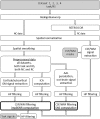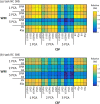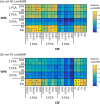Evaluation of different cerebrospinal fluid and white matter fMRI filtering strategies-Quantifying noise removal and neural signal preservation
- PMID: 30403309
- PMCID: PMC6865642
- DOI: 10.1002/hbm.24433
Evaluation of different cerebrospinal fluid and white matter fMRI filtering strategies-Quantifying noise removal and neural signal preservation
Abstract
This study examines the impact of using different cerebrospinal fluid (CSF) and white matter (WM) nuisance signals for data-driven filtering of functional magnetic resonance imaging (fMRI) data as a cleanup method before analyzing intrinsic brain fluctuations. The routinely used temporal signal-to-noise ratio metric is inappropriate for assessing fMRI filtering suitability, as it evaluates only the reduction of data variability and does not assess the preservation of signals of interest. We defined a new metric that evaluates the preservation of selected neural signal correlates, and we compared its performance with a recently published signal-noise separation metric. These two methods provided converging evidence of the unfavorable impact of commonly used filtering approaches that exploit higher numbers of principal components from CSF and WM compartments (typically 5 + 5 for CSF and WM, respectively). When using only the principal components as nuisance signals, using a lower number of signals results in a better performance (i.e., 1 + 1 performed best). However, there was evidence that this routinely used approach consisting of 1 + 1 principal components may not be optimal for filtering resting-state (RS) fMRI data, especially when RETROICOR filtering is applied during the data preprocessing. The evaluation of task data indicated the appropriateness of 1 + 1 principal components, but when RETROICOR was applied, there was a change in the optimal filtering strategy. The suggested change for extracting WM (and also CSF in RETROICOR-corrected RS data) is using local signals instead of extracting signals from a large mask using principal component analysis.
Keywords: RETROICOR; cerebrospinal fluid; fMRI; filtering; functional connectivity; nuisance regression; principal component analysis; psychophysiological interactions; white matter.
© 2018 Wiley Periodicals, Inc.
Figures













References
-
- Barton, M. , Marecek, R. , Rektor, I. , Filip, P. , Janousova, E. , & Mikl, M. (2015). Sensitivity of PPI analysis to differences in noise reduction strategies. Journal of Neuroscience Methods, 253, 218–232. - PubMed
Publication types
MeSH terms
Grants and funding
LinkOut - more resources
Full Text Sources
Medical

